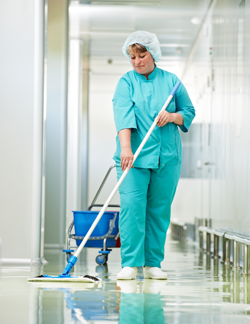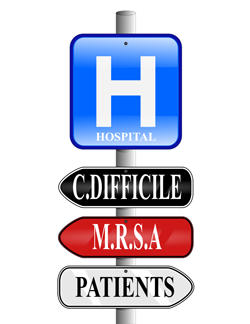Cleaning techniques and technologies that help reduce hospital-acquired infections
Originally published in Housekeeping Solutions on Clean Link Online
By Kassandra Kania

According to the U.S. Centers for Disease Control and Prevention (CDC), an estimated 5 percent of all hospital admissions result in infections that patients acquire while receiving treatment for other conditions. These hospital-acquired infections (HAIs), also known as nosocomial infections, result in 99,000 deaths each year and $28 billion to $33 billion in excess costs.
Despite the financial implications of government regulations and savvy consumers, a hospital’s priority is to protect the health of its patients. In so doing, many hospitals are turning to their environmental services departments to reduce hospital-acquired infections and prevent their spread.
A Clean Approach To Hospital-Acquired Infections
While cleaning and disinfecting high-touch surfaces are important steps to ensure that HAIs are contained, housekeeping departments find that many custodians aren’t doing an adequate job.
“I think too often we look at the disinfecting side of things, and we don’t do as good a job as we ought to on cleaning,” says Darrel Hicks, director of environmental services and patient transportation at St. Luke’s Hospital in Chesterfield, Mo. “We depend on poisoning rather than removing.” Laurie Tostenson, training and quality assurance manager for the housekeeping department of Dartmouth-Hitchcock Medical Center, Lebanon, N.H., agrees that more emphasis needs to be placed on cleaning techniques and less emphasis on products.
Laurie Tostenson, training and quality assurance manager for the housekeeping department of Dartmouth-Hitchcock Medical Center, Lebanon, N.H., agrees that more emphasis needs to be placed on cleaning techniques and less emphasis on products.
“So many times we get caught up in the tools: Are you using a phenolic? Are you using bleach? Are you using a quat?” she says. “But good cleaning and disinfecting comes down to basic fundamentals: Are you removing the gross matter before you start to disinfect? And when you do remove the gross matter, are you using force and friction? If you just spray or wipe something on, but you don’t use force or friction, you’re not cleaning the surface.”
To improve cleaning procedures that target hospital-acquired infections, environmental services departments need to focus on training custodians, as well as allowing them enough time in which to clean patient rooms. That is why Dartmouth-Hitchcock Medical Center has increased the amount of time its housekeepers spend cleaning a patient room from 20 minutes to 35 minutes. With the extra time, cleaners can focus on proper dwell times and hitting every high touch surface.
“Technology is being used in patient care and electronics are becoming part of the landscape at the bedside,” explains Tostenson. “These monitors, touchscreens, etc. have become our housekeeping responsibility, so we want to make sure these are also cleaned thoroughly between patients.”
A UV-Light Touch
But environmental services personnel are not only cleaning equipment, some hospital departments are turning to technology in the fight to eliminate hospital-acquired infections. For example, Mercy St. John’s Hospital in Springfield, Mo., is preparing to study the effectiveness of ultraviolet (UV) light in hospital infection control.
“We’re going to be looking at UV light versus [disinfecting] wipes and how these two relate to stop the spread of infection,” says Doug Green, director of environmental services.  The hospital plans to introduce UV light to some of its isolation units while continuing to disinfect with wipes in other units. After a set amount of time, Green will compare the results.
The hospital plans to introduce UV light to some of its isolation units while continuing to disinfect with wipes in other units. After a set amount of time, Green will compare the results.
“UV light technology has been around a long time, but using it in hospitals for cleaning is fairly new,” says Green.
That said, interest in the technology is growing. In fact, the University of Texas MD Anderson Cancer Center in Houston, has been using UV light for the past six months in its isolation rooms.
“We just finished a study on C. diff, and right now we’re monitoring MRSA,” says Babette Beene, environmental services manager. “After we disinfect the room and before we put the linens in, we run the UV machine to kill germs.”
The results have been encouraging.
“The doctors conducting the study test the room after we disinfect it and again after we use the UV machine,” explains Beene. “The outcome has been really positive, and they’re not finding any residuals left in the room.”
In addition to using the UV machine, MD Anderson Cancer Center relies on the APPA cleaning standards, as well APT testing of high-profile areas to keep as hospital-acquired infection rates low.
But despite the success of these technologies, housekeeping managers are quick to point out that there is no substitute for hand washing and proper cleaning procedures.
“Even with the technologies available to us, if everyone washed their hands like they’re supposed to, what would that do for infection?” asks Green. “And if housekeeping cleaned the room perfectly, covering every high-touch point, how would that affect the infection rate?”
Science has proven that reported cases would decrease. And, after all, these infections are what departments are working so hard to eliminate.
Kassandra Kania is a freelance writer based in Charlotte, N.C.
Source: http://www.cleanlink.com/hs/article/How-To-Reduce-HospitalAcquired-Infections--15216
-----------------------------------------------------------------------------------------------------------------------
Read More:
Preventing Hospital-Acquired Infections - http://www.cleanlink.com/hs/article/Preventing-HospitalAcquired-Infections--15215
Vomiting Larry Teaches Us About Norovirus -
http://info.debgroup.com/blog/bid/271088/?utm_campaign=blog&utm_source=twitter&utm_medium=social&utm_content=653418b5-8cab-4172-b92d-1a7e3633d89a
Hand Hygiene Solutions - http://info.waxie.com/hand-hygiene-easy-1-2-3
Ask Sadie: It's Flue Season! How You Can Stay Healthy - http://info.waxie.com/blog/bid/90839/Ask-Sadie-It-s-Flu-Season-How-You-Can-Stay-Healthy



